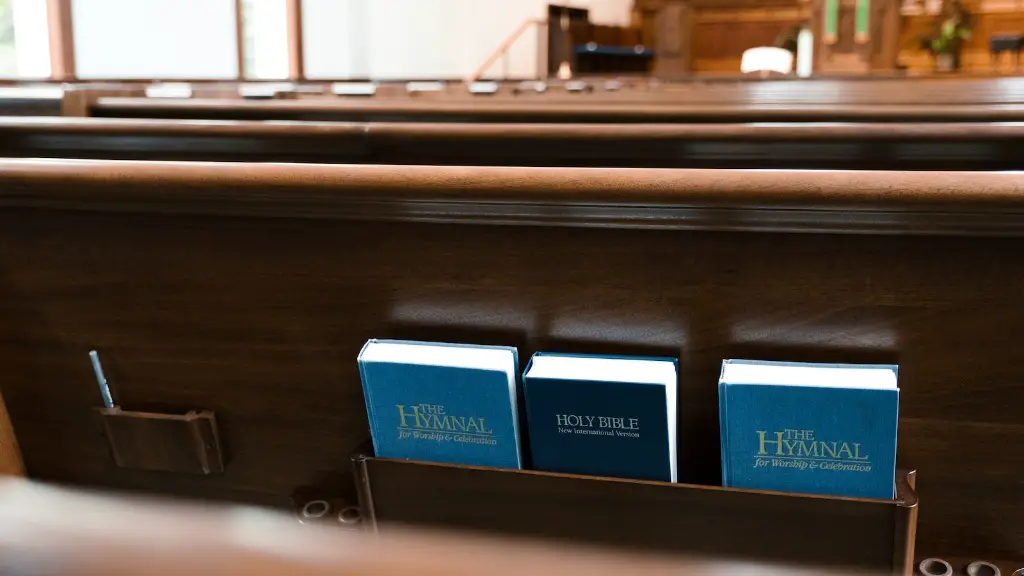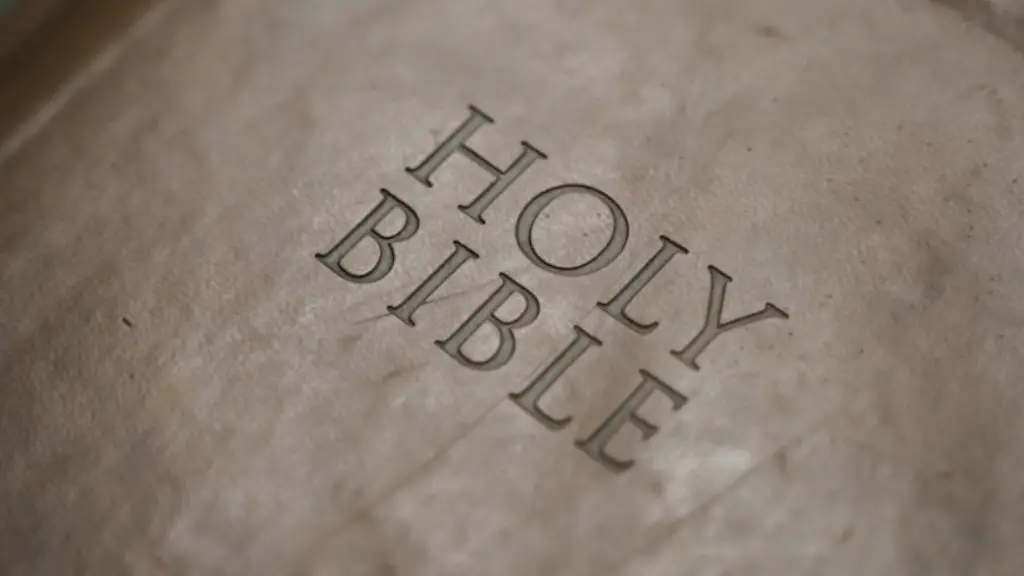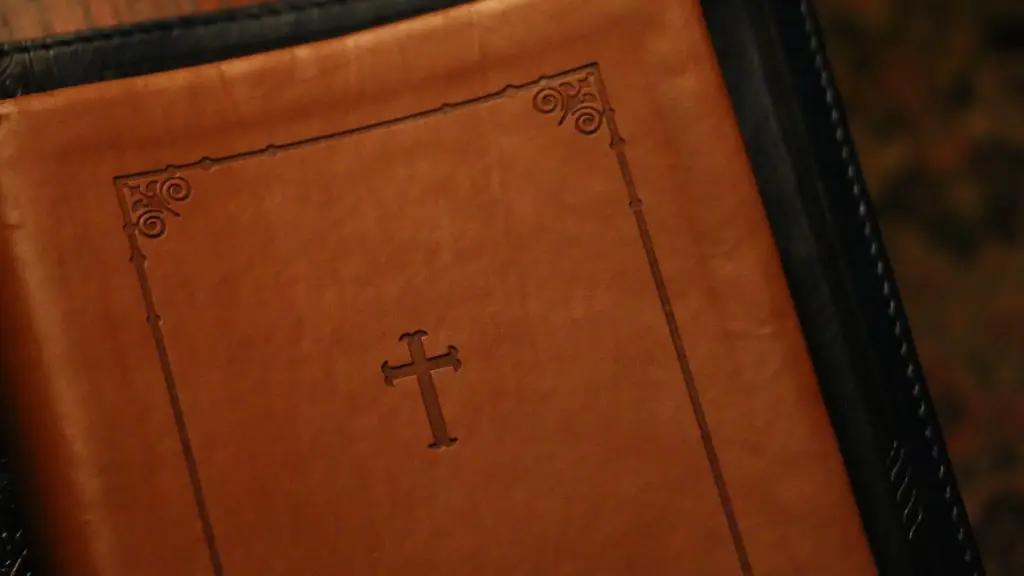The Bible is comprised of 66 small books, called “books” or “chapters.” The first 39 books are called the Old Testament, and the last 27 are called the New Testament. There are 920 chapters in the Bible.
The Bible is organized into two main sections: the Old Testament and the New Testament. The Old Testament contains the books that tell the history of the Jewish people before Jesus was born. The New Testament contains the books that tell the story of Jesus and the early Christian church.
What is the way the Bible is organized?
The Bible is divided into two main sections: the Old Testament and the New Testament. The Old Testament is further divided into four categories: the Books of Law, the Historical Books, the Poetic Books, and the Prophetic Books. The New Testament is also divided into four categories: the Gospels, the Historical Book, the Letters, and the Book of Vision.
These five scrolls are also known as the Books of the Law or the Pentateuch. They contain a great deal of religious and moral instruction, as well as the history of the early Israelites.
The first scroll, Genesis, tells the story of creation and the early history of mankind. It includes the stories of Adam and Eve, Noah and the Flood, and Abraham and his family.
Exodus tells the story of the Israelites’ escape from slavery in Egypt, and their journey through the wilderness to the Promised Land. Along the way, they receive the Ten Commandments from God.
Leviticus contains a great deal of laws and regulations concerning religious rituals and practices.
Numbers tells the story of the Israelites’ journey through the wilderness, and includes the famous story of the twelve spies.
Deuteronomy is a book of laws and instructions, as well as the story of Moses’ death and the Israelites’ entry into the Promised Land.
What are the 8 sections of the Bible
The Bible is divided into 8 sections, each containing different types of literature. Section #1 contains the law, which includes the books of Genesis through Deuteronomy. Section #2 is history, which includes the books of Joshua through Esther. Section #3 is poetry, which includes the book of Job and the Song of Solomon. Section #4 is prophecy, which includes the books of Isaiah through Malachi. Section #5 is the gospels, which includes the books of Matthew through John. Section #6 is history, which includes the book of Acts. Section #7 is the epistles, which includes the books of Romans through Jude. Section #8 is prophecy, which includes the book of Revelation.
The New Testament is a collection of 27 books written in Greek by 15 or 16 different authors between 50 CE and 120 CE. It can be divided into four groups: Gospels, Acts of the Apostles, Epistles, and Apocalypse.
The Gospels are four books that tell the story of Jesus’ life, death, and resurrection. The Acts of the Apostles tells the story of the early Church, and the Epistles are letters written by various authors to different churches. The Apocalypse is the book of Revelation, which describes the end times.
What are the four categories of the Bible?
The writings of the New Testament can be broadly divided into four categories: the Gospels, the Acts of the Apostles, the Epistles, and the Apocalypse.
The Gospels are the four books that tell the story of Jesus’ life, ministry, and death. They are Matthew, Mark, Luke, and John. These books are essential to understanding who Jesus was and what he did.
The Acts of the Apostles is a book that tells the story of the early Church, beginning with the Day of Pentecost. It chronicles the ministry of Peter and Paul, and the spread of the gospel throughout the world.
The Epistles are letters written by various New Testament authors, including Paul, James, and John. These letters provide instruction and guidance for Christians on how to live out their faith.
The Apocalypse is the final book of the Bible, and it tells the story of the end times. It includes Jesus’ return, the judgement of the world, and the establishment of his kingdom.
There are a few common formats for biblical citations. One is Book chapter:verses, using a colon to delimit chapter from verse, as in: “In the beginning, God created the heaven and the earth” (Gen 1:1). Another common format is to just use the Book and chapter, such as: “And the Lord God formed man of the dust of the ground” (Gen 2:7).
What are the 4 major themes of the Bible?
The great biblical themes are about God and his relationship with humanity. These themes include his revealed works of creation, provision, judgment, deliverance, his covenant, and his promises. These themes show God’s character and his plan for humanity.
The Christian Bible has two sections, the Old Testament and the New Testament. The Old Testament is the original Hebrew Bible, the sacred scriptures of the Jewish faith, written at different times between about 1200 and 165 BC. The New Testament books were written by Christians in the first century AD.
What are the three main parts of the Bible
The Bible is organized differently depending on which tradition you follow. For Christians, the Bible is divided into the Old Testament and the New Testament. The Old Testament includes the Hebrew Bible, which has three divisions: Torah (Instruction, or Law; also called the Pentateuch), Neviʾim (Prophets), and Ketuvim (Writings).
The Bible is divided into two major divisions: The Old Testament and the New Testament. The Old Testament consists of thirty-nine books and the New Testament is made up of twenty-seven books, a total of sixty-six books all together. The Bible is the sacred book of Christianity and is a collection of religious texts that provide guidance for living a Christian life.
Who wrote the Holy Bible?
The books of the Torah are traditionally considered to have been dictated by God to Moses. However, since the 17th century, scholars have viewed the original sources as being the product of multiple anonymous authors. Some scholars also allow for the possibility that Moses first assembled the separate sources.
The Rigveda is a sacred text of Hinduism that is dated to 1500 BCE. It is one of the oldest known complete religious texts that has survived into the modern age. The Rigveda contains hymns, prayers, and other sacred texts that are used in Hindu religious ceremonies. The Rigveda is an important source of information about the early history of Hinduism.
How is the Bible divided in chapters
The Bible is composed of the Old and New Testaments. There are 929 chapters in the Old Testament and 260 chapters in the New Testament. This gives a total of 1,189 chapters. Psalm 117 is the shortest chapter and is also the middle chapter of the Bible.
There is no right or wrong way to study the Bible. However, one way to approach your study is to begin with the book of Genesis and then read through the books in order: Exodus, Leviticus, Numbers, Deuteronomy, Joshua, Judges, Ruth, 1 and 2, Samuel, 1 and 2, Kings, 1 and 2 Chronicles, Ezra, Nehemiah, Esther, Jonah, followed by Acts. This approach will allow you to get a general overview of the main events and themes in Scripture.
How long after Jesus died was the Bible written?
The four gospels of the New Testament were written over the course of almost a century after Jesus’ death. They tell the same story, but reflect very different ideas and concerns. A period of forty years separates the death of Jesus from the writing of the first gospel.
There are many different genres of literature found in the Bible. Wisdom literature includes books like Job, Proverbs, and Ecclesiastes. Psalms are a genre of their own, and include books like the Psalms, Song of Solomon, and Lamentations. Prophecy is another genre, and includes books like Isaiah, Jeremiah, Ezekiel, and Daniel. The book of Hosea, Joel, Amos, Obadiah, Jonah, Micah, Nahum, Habakkuk, Zephaniah, Haggai, Zechariah, and Malachi are also classified as prophecy. The book of Daniel and the book of Revelation are classified as apocalyptic literature.
What are the 5 books of the Bible called
The Pentateuch includes the first five books of the Hebrew Bible: Genesis, Exodus, Leviticus, Numbers, and Deuteronomy. The literary category of the Pentateuch reflects the traditional Jewish grouping of these books together as the Torah. The Pentateuch is thought to have been written between the 13th and 10th centuries BCE, with the majority of scholars believing that it was compiled from earlier sources. The contents of the Pentateuch focus on the stories of the origins of the world, the patriarchs of Israel, the Exodus from Egypt, and the giving of the Law at Sinai.
The three main textual traditions of the Greek New Testament are often referred to as the Alexandrian text-type, the Byzantine text-type, and the Western text-type. These different text-types can be distinguished by their content and geographical origins.
The Alexandrian text-type is marked by its relatively concise and elegant style, as well as its tendency to preserve the original text free from errors and distortions. This text-type is thought to have originated in Alexandria, Egypt, where the earliest Greek copies of the New Testament were made.
The Byzantine text-type is characterized by its longer and more detailed readings, as well as its greater inclusion of later scribal additions and edits. This text-type was probably produced in Constantinople (modern-day Istanbul), the capital of the Byzantine Empire.
The Western text-type is distinguished by its shorter and simpler readings, as well as its greater number of textual variants. This text-type is most likely to have originated in the Latin-speaking West, where early copies of the New Testament were made in Latin instead of Greek.
Conclusion
The Bible is organized into two main sections, the Old Testament and the New Testament. The Old Testament includes the books of Genesis through Deuteronomy, while the New Testament includes the books of Matthew through Revelation. In addition, the Bible is divided into smaller sections, such as the Pentateuch, the Gospels, and the Epistles.
There are a variety of ways that people can choose to organize their Bible. Some people like to keep all of the Old Testament together and then all of the New Testament together. Others prefer to read chronologically, which means they would read the Bible in the order that the events actually happened. Some people also like to organize their Bible topically, which can be helpful when doing Bible studies on specific topics. Ultimately, it is up to the individual to decide how they want to organize their Bible.





